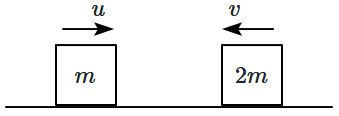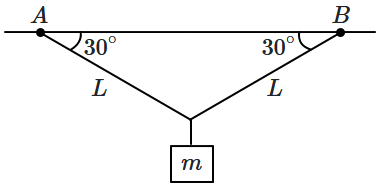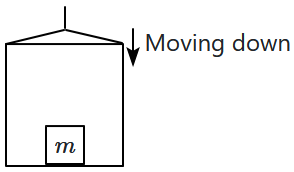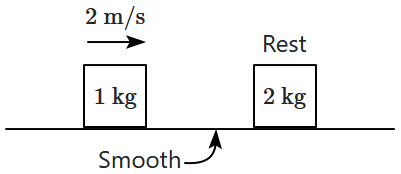Two blocks of masses \(m,2m;\) moving in opposite directions with speed \(u,v\) – undergo a collision. After the collision, the ratio of their speeds remains unchanged. Then, \({\Large\frac uv}=\)

1.
\(1\)
2.
\({\dfrac 12}\)
3.
\(\dfrac 21\)
4.
\(\dfrac 41\)

To unlock all the explanations of this course, you need to be enrolled.

To unlock all the explanations of this course, you need to be enrolled.

1. \(\sqrt{gL} \)
2. \(\sqrt{\sqrt3gL} \)
3. \(\sqrt{2gL\bigg(1-{\large\frac{\sqrt3}{2}}\bigg)} \)
4. \(\sqrt{2gL/\sqrt3} \)

To unlock all the explanations of this course, you need to be enrolled.

To unlock all the explanations of this course, you need to be enrolled.

1. \(20~\text J\)
2. \(40~\text J\)
3. \(30~\text J\)
4. zero

To unlock all the explanations of this course, you need to be enrolled.

To unlock all the explanations of this course, you need to be enrolled.

| 1. | \(mg\sqrt{gL}\) | 2. | \(\Large\frac{mg\sqrt{gL}}{2}\) |
| 3. | \(\Large\frac{mg\sqrt{gL}}{4}\) | 4. | \(\Large\frac{mg\sqrt{gL}}{2\sqrt2}\) |

To unlock all the explanations of this course, you need to be enrolled.

To unlock all the explanations of this course, you need to be enrolled.
(assume that the ball rebounds off a vertical surface and that the effect of gravity is negligible)

1. zero
2. \(50~\text{km/h}\)
3. \(100~\text{km/h}\)
4. \(150~\text{km/h}\)

To unlock all the explanations of this course, you need to be enrolled.

To unlock all the explanations of this course, you need to be enrolled.
1. \(mgu\)
2. \({\Large\frac{3}{4}}mgu \)
3. \({\Large\frac{1}{2}}mgu \)
4. \({\Large\frac{1}{4}}mgu\)

To unlock all the explanations of this course, you need to be enrolled.

To unlock all the explanations of this course, you need to be enrolled.

1. \(W_N=0,W_g>0\)
2. \(W_N>0,W_g=0\)
3. \(W_N=W_g=0\)
4. \(W_N+W_g=0\)

To unlock all the explanations of this course, you need to be enrolled.

To unlock all the explanations of this course, you need to be enrolled.
| Assertion (A): | In a swinging simple pendulum, the power delivered by gravity is maximum when the pendulum is at the lowest point. |
| Reason (R): | The speed of the pendulum bob is highest when it reaches the lowest point and the power is given by \((\vec F.\vec v).\) |
| 1. | Both (A) and (R) are True and (R) is the correct explanation of (A). |
| 2. | Both (A) and (R) are True but (R) is not the correct explanation of (A). |
| 3. | (A) is True but (R) is False. |
| 4. | (A) is False but (R) is True. |

To unlock all the explanations of this course, you need to be enrolled.

To unlock all the explanations of this course, you need to be enrolled.

The velocity of the first block, after the collision, is:
| 1. | \({\Large\frac12}~\text{m/s}\) | 2. | \(1~\text{m/s}\) |
| 3. | \(2~\text{m/s}\) | 4. | \(0~\text{m/s}\) |

To unlock all the explanations of this course, you need to be enrolled.

To unlock all the explanations of this course, you need to be enrolled.

The momentum of the system, as a result of the collision:
1. increases
2. decreases
3. remains constant
4. decreases suddenly and then increases

To unlock all the explanations of this course, you need to be enrolled.

To unlock all the explanations of this course, you need to be enrolled.
